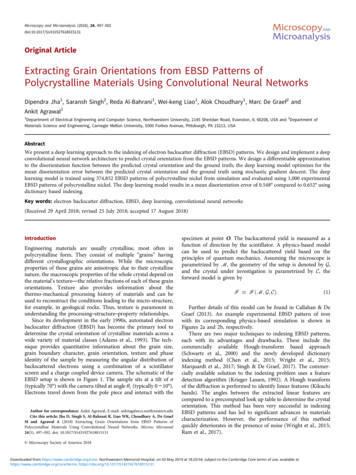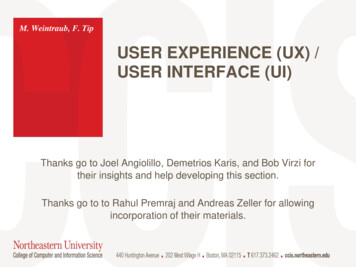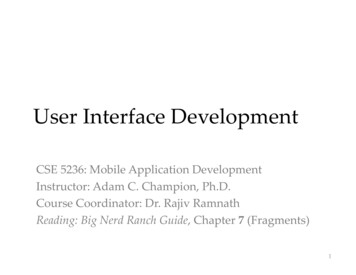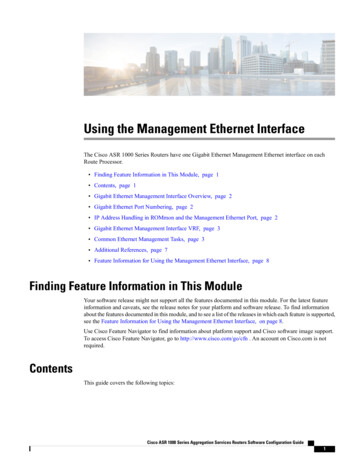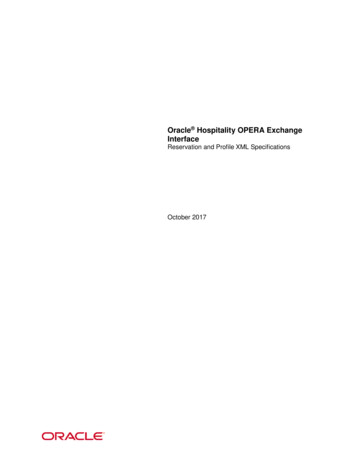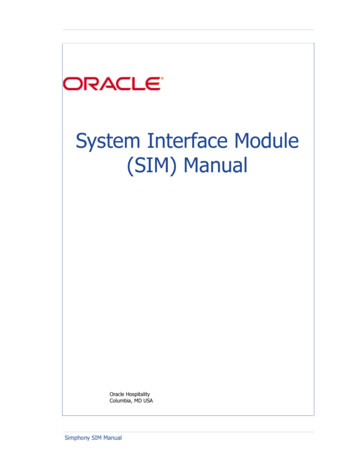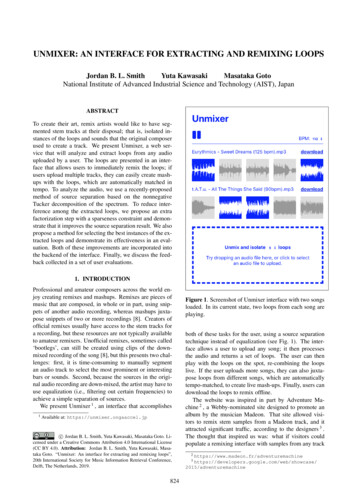
Transcription
UNMIXER: AN INTERFACE FOR EXTRACTING AND REMIXING LOOPSJordan B. L. SmithYuta KawasakiMasataka GotoNational Institute of Advanced Industrial Science and Technology (AIST), JapanABSTRACTTo create their art, remix artists would like to have segmented stem tracks at their disposal; that is, isolated instances of the loops and sounds that the original composerused to create a track. We present Unmixer, a web service that will analyze and extract loops from any audiouploaded by a user. The loops are presented in an interface that allows users to immediately remix the loops; ifusers upload multiple tracks, they can easily create mashups with the loops, which are automatically matched intempo. To analyze the audio, we use a recently-proposedmethod of source separation based on the nonnegativeTucker decomposition of the spectrum. To reduce interference among the extracted loops, we propose an extrafactorization step with a sparseness constraint and demonstrate that it improves the source separation result. We alsopropose a method for selecting the best instances of the extracted loops and demonstrate its effectiveness in an evaluation. Both of these improvements are incorporated intothe backend of the interface. Finally, we discuss the feedback collected in a set of user evaluations.1. INTRODUCTIONProfessional and amateur composers across the world enjoy creating remixes and mashups. Remixes are pieces ofmusic that are composed, in whole or in part, using snippets of another audio recording, whereas mashups juxtapose snippets of two or more recordings [8]. Creators ofofficial remixes usually have access to the stem tracks fora recording, but these resources are not typically availableto amateur remixers. Unofficial remixes, sometimes called‘bootlegs’, can still be created using clips of the downmixed recording of the song [8], but this presents two challenges: first, it is time-consuming to manually segmentan audio track to select the most prominent or interestingbars or sounds. Second, because the sources in the original audio recording are down-mixed, the artist may have touse equalization (i.e., filtering out certain frequencies) toachieve a simple separation of sources.We present Unmixer 1 , an interface that accomplishes1Available at: https://unmixer.ongaaccel.jpc Jordan B. L. Smith, Yuta Kawasaki, Masataka Goto. Licensed under a Creative Commons Attribution 4.0 International License(CC BY 4.0). Attribution: Jordan B. L. Smith, Yuta Kawasaki, Masataka Goto. “Unmixer: An interface for extracting and remixing loops”,20th International Society for Music Information Retrieval Conference,Delft, The Netherlands, 2019.824Figure 1. Screenshot of Unmixer interface with two songsloaded. In its current state, two loops from each song areplaying.both of these tasks for the user, using a source separationtechnique instead of equalization (see Fig. 1). The interface allows a user to upload any song; it then processesthe audio and returns a set of loops. The user can thenplay with the loops on the spot, re-combining the loopslive. If the user uploads more songs, they can also juxtapose loops from different songs, which are automaticallytempo-matched, to create live mash-ups. Finally, users candownload the loops to remix offline.The website was inspired in part by Adventure Machine 2 , a Webby-nominated site designed to promote analbum by the musician Madeon. That site allowed visitors to remix stem samples from a Madeon track, and itattracted significant traffic, according to the designers 3 .The thought that inspired us was: what if visitors couldpopulate a remixing interface with samples from any emachine3
Proceedings of the 20th ISMIR Conference, Delft, Netherlands, November 4-8, 2019they own? With Unmixer, we aim to achieve this vision.In the next subsection, we discuss alternative methodsof extracting loops. In Section 2, we explain the featuresof the interface and some design considerations. In Section 3, we explain the algorithm which supports it [22] andpropose an extension and improvement to it. Both contributions are evaluated. In Section 4, we present a usabilitystudy, and we end with a discussion (Section 5).1.1 Tools for extracting loops and creating remixesExisting interfaces for creating live remixes from a library of samples include AdventureMachine and BeatSync-Mash-Coder [7], but these do not allow you to populate the interface with automatically extracted loops. Theweb application Girl Talk in a Box 4 cuts any song intochunks for a user and offers novel resequencing options,but does not separate sources or allow the users to playmultiple chunks at once. Advanced users can always usea Digital Audio Workstation (DAW), which is the mostpowerful and flexible way to compose a remix, but theywill need to do the work of extracting loops on their own.That said, software exists to support this tedious task, suchas [3] and [18], both of which require users to guide thealgorithm by indicating regions of the spectrum to ignoreor focus on. In sum, we are not aware of another interfacethat, given an input song, extracts source-separated loopsand presents them to the user for remixing.To extract repeating patterns, two broad approachesare popular: kernel-additive modeling [10], includingharmonic-percussive source separation (HPSS) [4] andREPET, a method of foreground-background separationthat models a looping background, and its variants [17].However, these are binary separations: only two sourcesare obtained. The family of non-negative matrix factorization (NMF) approaches includes NMF [21], NMFdeconvolution [19], and non-negative tensor factorization(NTF) [5]. All take advantage of redundancies in thesignal—repeating spectral templates, transpositions, stereodependence, etc. By applying NMF iteratively, [20] separated layers of electronic music that built up progressively,but did not model the extracted sources in terms of loops.This is a drawback shared by all of these algorithms: theyproduce full-length separated tracks. To obtain short, isolated loops, some extra step is required. However, a recent NTF system [22] models the periodic dependenciesin the signal and is thus suitable for extracting loops directly; it forms the basis for our system and is describedin Section 3. An orthogonal approach to extracting loopsis that of [12], which seeks only to extract drum breaks(short drum solos that are desirable for remixes) by devising a percussion-only classifier.2. WEB SERVICE AND INTERFACEThe purpose of the interface is to allow users to remix andmash-up the songs they love, and to perform automatically4the work of isolating loops, normally done through editingand equalization or source separation.The interface has just a few, simple features, all visible in the screenshot (see Fig. 1). To begin, a user mustupload a song from their hard drive, using the box at thebottom of the page. They may adjust the number of loopsto extract using the drop-down list, with possible values between 3 and 10. The audio is processed on the web serverusing the algorithm outlined in Section 3; once the audiohas been analyzed, the interface is populated with a set ofloop ‘tiles’, each tile bearing a waveform sketch. The possible actions are then:1. click on loop tiles to activate or deactivate them;2. change the global tempo (drop-down list at top-rightof the interface);3. pause playback (button at top-left);4. download a zip archive containing all the loops for agiven song;5. choose an additional song (and number of loops toextract) using the box at the bottom of the page.Uploading and processing a new file can take a while (currently between 5 and 10 minutes), but users can still usethe other functions (playing tiles and changing the tempo)while waiting for the next batch of tiles. Users can add anynumber of songs to a single workspace.All the loops have the same duration (equivalent to twobars of audio), and the playback of the loops is synchronized so that the downbeats align, no matter when the useractivates them. When a user uploads the first song, theglobal tempo is set to the detected tempo. New songsadded to the workspace are tempo-shifted to match theglobal tempo.The interface was built as a web application using React 5 , making it available on any web-accessible devicethrough a browser. To handle audio playback, we use theWeb Audio API, making it easy to synchronize playbackof all the tiles and control the playback rate. The audioanalysis is run on our server, using the algorithm describedin the next section. The web server keeps a log of uploaded audio files and the analysis computed for each. Tosave time, if the system recognizes an uploaded audio file,it re-uses the old analysis. However, it does not re-use theold audio; it re-extracts the component loops from the newaudio to return to the user, thereby avoiding any copyrightissues related to redistributing audio.3. LOOP EXTRACTIONOur approach to extracting loops is based on [22], butwe make two contributions: first, we suggest and evaluatemethods for selecting individual loops; second, we proposeand evaluate an extra “core purification” step.3.1 Review of NTF for source separationThe pipeline for our system, based on the work of [22],is shown in Fig. 2. First, the mono spectrogram X is ttps://reactjs.org/
Proceedings of the 20th ISMIR Conference, Delft, Netherlands, November 4-8, 2019(a) X X(b) X C (W H D)Figure 3. Example reconstruction of spectrum for a single loop (#2) from multiple (freq, rhythm) combinations(above), and for a single bar (#4, also indicated in Fig. 2)from multiple loops (below).Figure 2. Overview of system, using example ‘125 acid’[11]. (a) Spectrum of 8-bar song reshaped into tensor. (b) Tucker decomposition expresses song as productof frequency templates W , rhythm templates H, repetition templates D, and a core tensor C. In this example,(M, P, Q) (1025, 661, 8) and (rw , rh , rd ) (32,20,4).vided into downbeat-sized windows using a beat-tracker.(Unmixer uses the madmom system [1], but the illustratedexample uses the known downbeats.) The M P -shapedspectrogram windows (one for each bar) are stacked into anew dimension, creating an M P Q tensor X (Fig. 2a).Then, using Tensorly [9], we compute the non-negativeTucker decomposition (NTD) with ranks (rw , rh , rd ), approximating the tensor as the outer product X C (W H D) (Fig. 2b). In plain terms, the NTD models thespectrum with three meaningful components: a set of spectral templates W (the sounds), a set of within-bar timeactivation templates H (the rhythms), and a set of loopactivation templates D (the layout, i.e., the arrangement ofloops in the song). In Fig. 2b, a decomposition of an artificial 8-bar (W 8) stimulus [11] has been approximatedusing rd 4 loop templates, giving a good estimate of thelayout of the piece (shown in Fig. 6). The templates arediverse: some sounds are monophonic, others polyphonic;some rhythms are percussive, others sustained.The sparse core tensor is C; a non-zero element C[i,j,k]indicates that sound i is played with rhythm j, and this pattern is repeated according to layout template k. To separatethe contribution of the k th loop, use the k th row of D totake the outer product C (W H Dk ) Xk , and unfoldthe tensor into Xk . The reconstructed real-valued spectrum Xk is not sufficient to recreate the signal; we mustapply softmasking (as outlined in [17] and implemented inlibrosa [13]) and use the original phase:yk ISTFT(phase(X) · mag(X) ·Xkp)Xkp X p(1)where p is the power of the softmask operation. As noted826by [6], using softmask filters is convenient, although notnecessarily optimal, for non-negative approaches like ours.The core tensor can be interpreted as a set of “recipes”for building the loops, the recipe for the k th loop being therw rh slice of the core tensor C[:,:,k] . To see how, note thatWi Hj , the outer product of the ith sound with the j thrhythm, is an M P spectrum of a single bar. The outerproduct C[:,:,k] (W H) thus represents a sum of suchone-bar spectra, leading to the k th loop template. Fig. 3shows how the 2nd loop template is the sum (in descendingorder of magnitude) of individual Wi Hj components.Each bar in the piece will be a superposition of severalloops: the bottom part of the figure shows how the 4th barconsists of copies of each loop.3.2 Loop selectionThe output of the algorithm in [22] is a set of full-lengthtracks, each corresponding to the contribution of one loop.For remixing purposes, we only want a bar-length versionof each loop, as cleanly separated as possible. The plainapproach is to extract the full-length track, then excerpt asingle bar, but the question is then: which bar to select?There are at least two factors to consider: how louda given loop instance is, and how strongly that instancestands out from the other parts. Loudness can be maximized by choosing the bar that takes the maximum value inthe loop activation matrix: i.e., to select the best bar for thek th loop, choose argmax(D[k,:] ). To minimize cross-talk,we consider two approaches. First, we may normalize thecolumns of D by choosing argmax(D[k,:] D̄), where D̄is a vector of the column means of D.Alternatively, the coefficients from the softmask operation could estimate how prominently a given loop standsout from the background. In this approach, we computethe softmask coefficients for each bar (i.e., the fractionalpart of Equation 1), and then select the bar which maximizes the total value of the mask. That is, if Mk,i gives thesoftmaskPmatrix for the ith bar for the k th loop, we selectargmax( Mk,: ). Finally, we may combine any or all ofthese decision criteria.Evaluation To determine the most reliable selectionmethod, we tested them on a set of stimuli assembledby [11]. The test set
pose loops from different songs, which are automatically tempo-matched, to create live mash-ups. Finally, users can download the loops to remix ofine. The website was inspired in part by Adventure Ma-chine 2, a Webby-nominated site designed to promote an album by the musician Madeon. That site allowed visi- tors to remix stem samples from a Madeon track, and it attracted signicant trafc .


